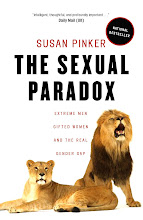
This week six different people emailed me an article from the New York Times describing how women’s opportunities in science and engineering are now are comparable to men’s. That's great news, as I agree with Arthur Brooks, "To focus our policies on inequality, instead of opportunity, is to make a grave error.."
The article also mentioned a new study showing that any gender gap in math performance has now disappeared, according to research by Janet Hyde at the University of Wisconsin, and therefore any previously reported gaps were due to gender bias. I’m skeptical.
While I agree that (a) there are many girls and women who are terrifically talented in math, and that (b) strong or weak, people should have every opportunity to learn, and (c) the averages in math performance between boys and girls are pretty similar, I also think that many journalists who report on this issue are still confused about whether little differences in averages means there are no differences between the sexes at all (there can be a huge difference in variability--how many are in the extreme high and low brackets—and still, a lot of similarity in group averages). Their confusion affects public understanding. Let’s face it, many of us want there to be no differences between boys and girls in math (even though no one mentions girls’ consistently stronger reading scores everywhere in the world). But when parity in math test scores is reported, there’s a reassuring “aha!” feeling-- also called confirmation bias. It helps us discount any evidence that doesn’t fit our values, or our expectation of how the world “should” work. But science is not about “should.” It’s about “is.
Whatever our values, it’s important not to dumb down or gloss over science because it doesn’t fit a preconceived notion of a mathematically divided world, and for better or worse, since the Sexual Paradox first came out, greater variability among boys and men has continued to pop up in various countries and on different types of tests. In Norway, for example, a 2009 study of the birth weights of 48,000 babies shows that there are more extremely underweight and overweight baby boys born than girls; both are linked to later health problems. The researchers also found more dramatic highs and lows among males when they measured adult height and weight, when they looked at teenagers’ performance on the 60 meter dash, and at how well university students do on their exams.[i] Almost everywhere researchers look—whether in birthing rooms, childhood intelligence tests, high school track meets, on college transcripts, or on math tests, boys’ greater variability shows up. And sometimes, the greater number of boys with developmental and genetic syndromes means that the bell curve is more bottom heavy with males than it is at the top.[ii]
Nonetheless, preferences and male extremes were overlooked in Janet Hyde's study of math performance. Prof. Hyde examined math averages from 7 million American students between the ages of 7 and 16 tested through the No Child Left Behind initiative, and concluded that “our analysis shows that for grades 2 to 11, the general population no longer shows a gender difference in math skills.” This is a cheerful conclusion—but it leapfrogged over two reasons why gender differences that show themselves everywhere else were suddenly invisible in this study. First, every state is motivated “not to leave any children behind” lest they lose out on federal funding. As a result No Child Left Behind tests have a very low threshold of success. Their low ceilings mean that higher performing students disappear into the mix. And sex differences are most remarkable at the extremes. While Professor Hyde is surely right that any difference between boys’ and girls’ average performance is insignificant—and that there are a great many girls who are excellent at math—greater male variability means that the bottom and top one percent of math test takers are typically male. The second problem is that math gaps typically emerge in high school and college, not in primary school, as Professor Hyde herself noted in 1990. By including second and third grade scores along with those of kids graduating from high school, Hyde and her colleagues diluted any variability, and thus nothing significant showed up.[iii]
[i] Ibid
[ii] Wendy Johnson, Andrew Carothers and Ian J. Deary. “Sex Differences in Variability in General Intelligence,” Perspectives in Psychological Science 3, no.6 (2008)
[iii] Janet S. Hyde, Sara M. Lindberg, Marcia C. Linn, Amy B. Ellis, and Caroline C. Williams, “Gender similarities characterize math performance,” Science 321, no. 5888 (2008).
http://www.lagriffedulion.f2s.com/math2.htm, accessed December, 2008.


As women still seem dominated by the need to be a family, how can most of them ever aspire to an intellectual life?
ReplyDeleteI don't think that an intellectual life and family are mutually exclusive. Sometimes there is even cross-over from one sphere to the other. Writers such as Ayelet Waldman, Fay Weldon, Betty Friedan and Erma Bombeck based their careers on their observations of family life,though I think it is more common for women to make their intellectual marks before babies arrive and after they reach school age and have achieved quasi-independence. As women live longer than men do, it makes more sense to see their trajectory of achievements over the long term, and not as a short dash during their 20s and 30s, which is the male model of success.
ReplyDelete